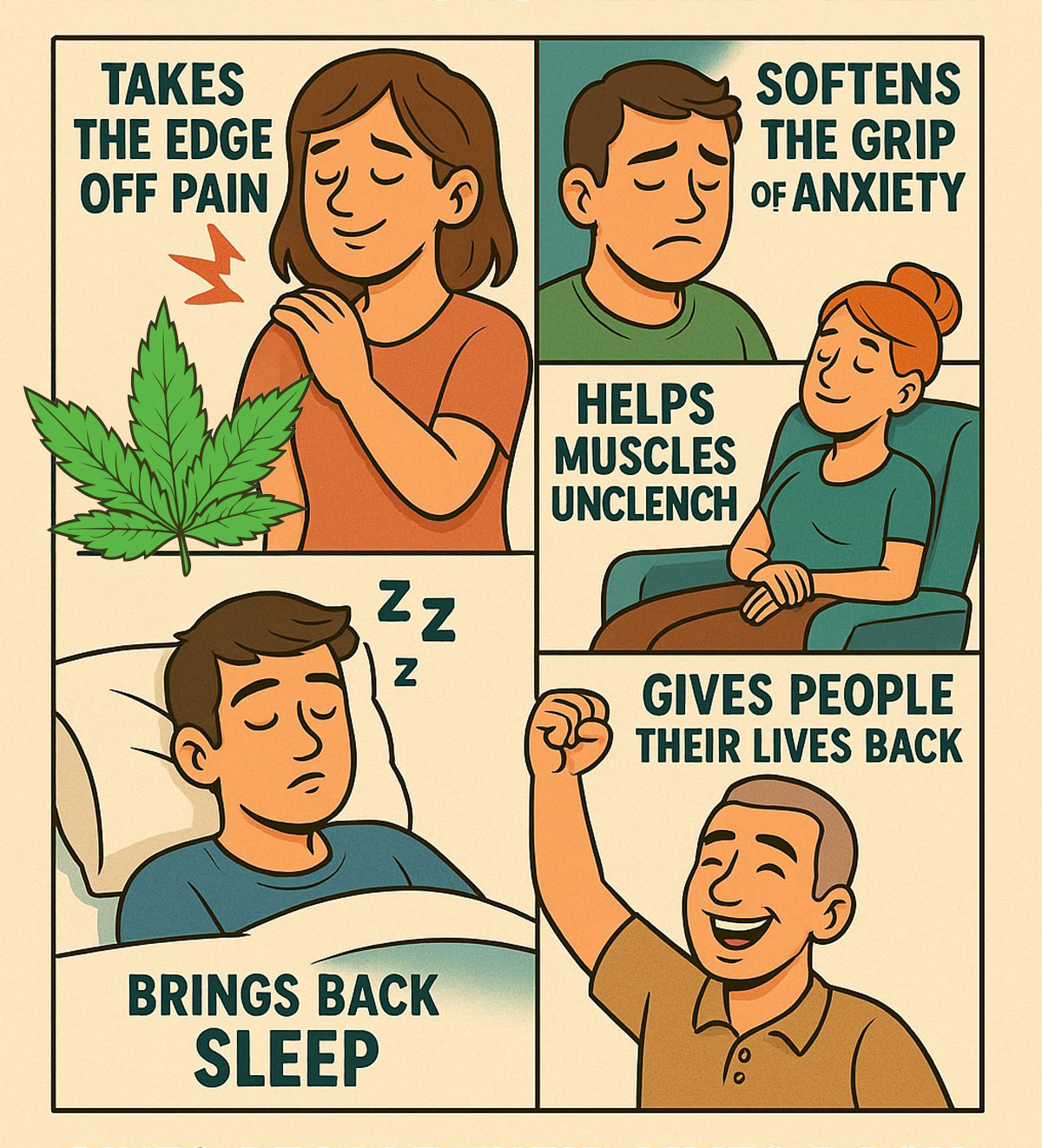Author: Dr. Kim, Medical Doctor at Aurea Care (Pen name)
Let’s get one thing straight: cannabis isn’t magic.
It won’t regrow cartilage. It won’t delete your trauma. It won’t fix your pancreas or lower your taxes. It won’t make you enlightened (though it might make you think you are for a few hours — which is fun until someone hands you a guitar).
But here’s what it will do — and does, consistently, across thousands of patients and an expanding pile of data:
It takes the edge off pain, softens the grip of anxiety, helps muscles unclench, brings back sleep, and in some cases, gives people their lives back.
That’s not nothing. That’s a big deal.
Especially for patients who’ve tried everything else. Especially for doctors who are tired of handing out pills with five side effects per benefit. Especially in a healthcare system where complexity often gets treated like an inconvenience rather than a reality.
Let’s cut through the smoke and talk about what medical cannabis actually does well. Not what influencers claim, not what the loudest critic fears, not what the stoned guy on YouTube thinks. Just what the data shows. And more importantly, what patients feel.
1. Chronic Pain: Where It Shines
Pain is weird. It’s not just a signal — it’s a story your brain tells you about your body. And sometimes, it gets the story wrong.
Especially in chronic pain, where the original injury might be long gone, but the narrative loops forever. Opioids can dampen that signal, but they do it with handcuffs. NSAIDs work for inflammation, but they hit your stomach and kidneys like a wrecking ball. Antidepressants and antiepileptics get thrown in because, well, we’re desperate.
Cannabis? It’s not perfect. But for many patients, it brings relief without sedation, numbness, or spiraling side effects.
Mechanistically, cannabinoids like THC and CBD interact with the body’s endocannabinoid system
— a sort of built-in chemical feedback loop that regulates pain perception, among other things. THC modulates nociception through CB1 receptors in the central nervous system. CBD doesn’t bind well to those receptors, but it can indirectly dampen inflammatory pathways and even tweak how other neurotransmitters behave.
In practical terms, this means a patient with fibromyalgia, arthritis, or post-surgical neuropathic pain might feel more like themselves again — not drugged, but balanced. The pain is still there, maybe, but its volume knob is turned down from eleven to four. That’s a win.
A woman with rheumatoid arthritis told me she didn’t notice the pain go away — she noticed she could knit again. That’s the difference. This includes not just fibromyalgia or post-surgical pain, but even spasticity in conditions like MS, where other meds often fail or sedate.
2. Sleep: A Crowbar for Racing Minds
Let’s talk about sleep — or the lack of it.
Insomnia is rarely about “not being tired.” It’s about not being able to let go. Thoughts race. Muscles twitch. Cortisol sneaks in at 2 a.m. with a to-do list and a megaphone.
Cannabis helps many people fall asleep faster. THC shortens sleep latency (the time it takes to drift off) and increases deep sleep. CBD, in low-to-moderate doses, can reduce nighttime anxiety. For people with pain or PTSD, cannabis often kills two birds with one inhale.
But — and here’s the important part — not all cannabis is good for sleep. Too much THC can backfire and reduce REM sleep. High doses of CBD can actually promote wakefulness. The strain, ratio, timing, and dose all matter. It’s a scalpel, not a sledgehammer.
Still, for the right patient, cannabis can be a better alternative than zopiclone, benzodiazepines, or antihistamine sedatives — all of which come with risks of tolerance, dependence, and next-day hangover.
3. Anxiety: Not a One-Size-Fits-All Tool, But a Powerful One
Anxiety is a slippery fish. Everyone wants a quick fix, but most solutions are either too blunt or too slow. SSRIs take weeks and might blunt your emotions. Benzos work fast but come with the baggage of tolerance and addiction.
Cannabis, when used correctly, can offer rapid, gentle relief — especially when anxiety is tied to trauma, neurodivergence, or chronic illness. CBD in particular shows strong anxiolytic properties in both animal models and human trials. It modulates the serotonin 5-HT1A receptor, among other effects, and seems to reduce amygdala reactivity (i.e., the brain’s panic button).
But again: dose and context matter.
Too much THC can cause anxiety in some people. Especially if taken in unfamiliar environments, or if the patient has a tendency toward panic. That’s why education, titration, and a doctor who actually listens is key. But when you get it right? It’s like someone loosens a knot that’s been there for years.
4. Appetite, Nausea, and Gut Problems
THC is famously good at making people want to eat. That’s not just a munchies joke — it’s a therapeutic lever.
For cancer patients undergoing chemotherapy, cannabis can suppress nausea and restore appetite where nothing else works. For people with wasting syndromes (like HIV/AIDS), it can help maintain weight. And for certain types of inflammatory bowel disease, cannabinoids can reduce cramping, gut spasms, and improve quality of life. Even when the inflammation itself is still present.
CBD, too, has some gut-soothing effects via the enteric nervous system. And the combined effect? A calmer, hungrier, less-nauseated patient who can finally eat and sleep.
What It Doesn’t Do (and That’s Okay)
Cannabis is not a cure for cancer. It doesn’t melt tumors. It doesn’t reverse autoimmune diseases. It doesn’t regenerate cartilage, cure addiction, or fix severe psychiatric conditions like schizophrenia.
Can it help manage side effects in some of these cases? Yes. Can it replace standard treatment? Usually, no.
It’s also not a harmless panacea. Some patients get dizzy. Others get anxious, groggy, or foggy. A few become psychologically dependent (though this risk is far lower than with alcohol, tobacco, or opioids). It interacts with other medications — especially those metabolized by liver enzymes like CYP3A4. And it’s not always well tolerated in the elderly or cognitively fragile.
In other words: it’s a tool. A good one. But still a tool.
Final Thoughts: The Real Value of Cannabis Isn’t Just What It Treats
What cannabis does best, in the end, is give people a sense of agency. It’s not just about symptom relief — it’s about control. About paying attention, adjusting what works, and no longer being a passive recipient of prescriptions. And maybe, for once, sleep without begging for it. That’s not just relief. That’s control.
Cannabis doesn’t fix everything. But when you’re stuck in a broken system, dealing with a body that won’t cooperate, even a 30% improvement in pain or sleep or function can feel like getting your life back. The woman who could knit again? That’s cannabis done right.
That’s not a miracle. That’s medicine. And it’s about time we treated it that way.

